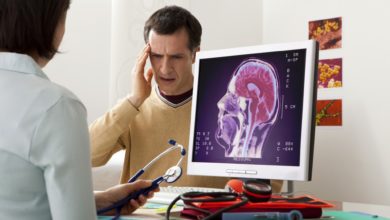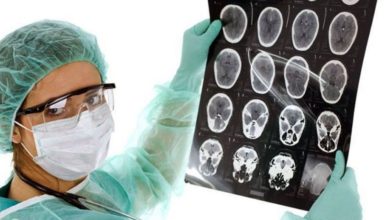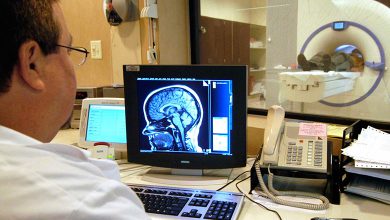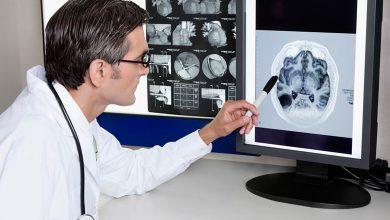Meningioma of the brain - life prognosis
The content of the article
The most common benign tumor is meningioma of the brain, the prognosis of life after which depends on many factors:
- Tumor size and location;
- Patient's age;
- Histological type of meningioma;
- Presence of chronic diseases.
Patients can develop several infected areas at the same time, and malignant meningomas can also form, but more on that a little later. Initially, you need to understand in more detail what meningioma is?
Meningoma is a tumor that forms from the arachnoid membrane of the brain or spinal cord. It mainly differs in spherical shape and is often fused with the dura mater of the brain. Most often, meningoma is a benign tumor, but any neoplasm that appears in the cranial cavity can become malignant, since as the infected lesion grows, symptoms may appear that were caused by compression of the brain substance.
Causes of the disease
There are no direct causes for the formation of such tumors. There are only risk factors through which meningoma can appear:
- Age over 40 years;
- Gender criterion. As practice shows, the risk of developing such tumors in women is three times greater than in men. This is due to the influence of hormones such as estrogen and progesterone, which provoke its growth. Men are less likely to develop meningomas, but they are more likely to have a malignant type of tumor. The most common form of this disease is convexital meningioma;
- Large ionizing radiation, which provokes the formation of various tumors in the cranial cavity. Today, this statement is controversial, since recent studies have shown that the occurrence of meningomas is associated precisely with a small amount of radiation;
- Genetic diseases. Most often, malignant meningomas are formed as a result of the presence of neurofibromatosis type 2.
Symptoms
Very often, meningoma may not show any symptoms, so its presence may be discovered accidentally during magnetic resonance imaging, which was performed for other reasons. In most cases, the signs are initially very vague and develop gradually.
General cerebral symptoms include the following:
- Headache , which gradually increases, especially at night or even after lying down for a short time. Patients report an unbearable attack of pain, which can be compared to a migraine. This symptom is characteristic of many meningomas, but most often it is caused by a meningotheliomatous tumor;
- Violation of visual processes (loss of acuity, double vision, etc.). Restoration of vision is directly related to the effectiveness of treatment of the disease;
- Severe nausea and increased gag reflex during meals;
- Changes in the psyche and memory impairment. Very often, relatives of people who suffer from meninges note that patients suffer from retrograde amnesia, that is, events that happened a few minutes ago “fall out of memory.” As for changes in the psyche, this is provoked by an increase in anger and aggression. Often patients become depressed and close themselves off from others;
- Weakness in the limbs, which most often manifests itself on one side of the body. Patients lean to one side while walking and are unable to hold objects with their hands in the affected area. Falx meningioma also causes problems, in which patients may lose their legs;
- Epileptic seizures, which are initially accompanied by convulsions. Experts do not always give comforting results regarding the complete cure of this disease.
Symptoms depending on tumor location
There are also signs that appear at different locations of infected tissues:
- Meningoma of the tuberculum sella causes unilateral or bilateral blindness;
- Being in the cerebellum area provokes severe headaches, which are caused by poor circulation in the brain stem. It is worth noting that this type of disease can cause loss of the patient's limbs depending on the location of the tumor;
- On a section of the orbit. Accompanied by protrusion of one eye outward;
- In the region of the frontal lobe of the brain. Causes hearing and speech impairment;
- In the wing part of the main bone. Accompanied by impaired visual contact, causes hallucinations, as well as split images;
- Meningioma of the olfactory fossa causes severe obsessive headaches, changes in the psyche appear, which are accompanied by epileptic seizures, euphoria and depression, and unilateral or bilateral impairment of smell may also appear;
According to the nature of formation, meningomas can be as follows:
- Atypical. These are stage 2 malignant tumors. It is accompanied by rapid growth, and an increase in neurological symptoms is observed;
- Anaplastic meningoma. A malignant type of tumor, which is accompanied by rapid growth and an increase in neurological symptoms;
- Fibroplastic. This is a malignant variety, which occurs much more often than benign ones (in 2/3 of all patients). Such a tumor is accompanied by slow growth and practically asymptomatic existence. It is discovered by chance during an MRI and CT scan (intraosseous meningioma can be detected by purposefully undergoing these procedures).
Treatment of brain meningoma
Before answering questions about how a brain meningioma is removed, how the operation is performed and many others, it is worth noting that the choice of treatment algorithm depends on many points:
- Type of tumor and its size;
- Localization;
- Symptoms;
- General condition of the patient;
- The patient's ability to withstand the procedure.
Four approaches are used to treat brain meningoma:
- Dynamic monitoring of the development of meningoma. The patient is under constant monitoring, and the condition of the meningoma is determined through MRI, which the patient undergoes every six months. This method is not used for patients with large tumors. This method is suitable for elderly people, as well as patients with serious health problems that do not allow for more thorough treatment;
- Surgical removal of meningioma. Surgical removal of infected cells has many advantages. If the tumor is benign and can be completely removed, then the percentage of quick and final cure is extremely high. In addition, tissue removal allows specialists to establish a more accurate diagnosis of the patient. Treatment of meningioma in Israel often involves surgical intervention.
This method is most favorable for a disease such as anaplastic meningioma, which develops very quickly and can affect healthy tissue, so in this case surgical intervention is required.
- Stereotactic radiosurgery. Precisely directed beams of radiation are used that destroy tumor cells without damaging healthy tissue;
- Traditional radiation therapy . This method is used to treat malignant neoplasms that are difficult to localize, or to treat patients with very large lesions. As practice shows, beam treatment is not as successful as radiosurgery, and therefore remains not the main method of treatment.
Contraindications
If a patient has been diagnosed with menigoma of the brain, he should know the following instructions:
- It is prohibited to drink alcoholic beverages. Otherwise, this may provoke a worsening of the situation, as well as increased tumor growth;
- It is prohibited to take many neotropic drugs, as well as B vitamins and tablets to stimulate metabolism. Medicines can only be taken after consultation with your doctor;
- It is prohibited to use homeopathic remedies without the permission of a specialist;
- Contraception is prohibited.
Rehabilitation
Removal of brain meningoma in some cases is a very serious operation that requires a long period of rehabilitation, especially if the patient has suffered severe damage as a result of the presence of infected tissue. It is worth understanding that rehabilitation after removal of meningioma involves the patient leading only a healthy lifestyle (gymnastics, complete abandonment of bad habits, proper diet, healthy sleep, etc.).
To speed up recovery processes, a specialist may prescribe physical therapy (acupuncture and various medications) to the patient. The list of drugs includes drugs that are used to reduce pressure in the skull. Other drugs are used as needed, for example, to relieve edema, tumors, and also to relieve neurological manifestations.
Experts note that the following recipes have a positive effect on the patient’s accelerated recovery:
- Tinctures with clover color. To prepare such a remedy, you need to take 20 grams of plant buds and pour all 500 ml of vodka or alcohol. This remedy should be infused for two weeks. You can take it no more than 1 tablespoon after meals;
- Tincture of celandine. This remedy is prepared in a similar way, and helps stop the development and growth of cancer cells. The dosage is different for each patient, so before using the tincture you should consult a specialist.
Removing meningoma without surgery
Basically, meningomas are benign tumors, and therefore do not require surgical intervention, since they do not affect internal organs and are not a threat to human life. In this case, treatment can be carried out without surgery. As for malignant tumors, in this case surgery is mandatory.
Today, the most common non-surgical treatment for meningioma involves the use of a unique system of focused and precisely aimed beams of radiation at the infected area. This beam destroys harmful cells without affecting healthy tissues that are located nearby. The effectiveness of this method is very high: approximately 95% of all meningomas stop growing after just one procedure and a short course of treatment, so the prognosis for life without surgery for the patient is very positive. There is a danger that with a disease such as brain meningioma, treatment without surgery can again resume the growth of infected tissue, but still the consequences after surgery can be much worse than without surgery.
Forecasts
If meningoma has been classified as a benign tumor, then in most cases there is a complete recovery, without relapse. Statistics show that within 5 years, only 3% of all patients may experience a recurrence of pathology. If we are talking about a disease such as atypical meningioma of the brain, the prognosis in this case is as follows - the probability of relapse is from 35% to 40%.
It is worth noting that if the meningioma was completely removed during treatment rather than partially, then the chance of a complete recovery is much higher. The following factors also influence the healing process:
- Presence of diabetes mellitus;
- Damage to the coronary vessels;
- The presence of atherosclerosis, etc.
After surgery, the consequences can be very different, ranging from damage to the organs of hearing, vision, speech, mobility, depending on the damage to individual areas of the brain. In general, treatment of these consequences is impossible. That is why it is necessary to undergo regular examinations that will help identify a possible disease at its earliest stages.
Treatment with folk remedies
Treatment of meningioma necessarily includes conservative methods, but modern medicine allows them to be combined with the use of folk remedies. There are several recommendations for those patients who have been diagnosed with benign brain tumors:
- It is recommended to completely abandon table salt, as well as increase the intake of vitamins D and A. It is necessary to completely abandon bad habits and increase the amount of fermented milk products in the diet;
- Take decoctions of calendula flowers. You can buy them directly at the pharmacy. They are sold both in the form of dry herbs and in special filter bags that can be immediately brewed into tea. You need to take such decoctions three times a day;
- An excellent remedy is a decoction of viburnum fruits. To do this, you need to mash the fruits, pour boiling water over everything and let it brew for 30 minutes. Take one glass of decoction three times a day;
- To eliminate or reduce fluid accumulation, it is recommended to use compresses and lotions based on medicinal clay. It is applied in a thick layer to the area of the head where the tumor is located. A teaspoon of vinegar must be added to the clay, and the compress itself must be kept on the head area for two hours;
- Decoctions of mint and rosehip help well. The herbs are brewed like tea and infused for 15 minutes. Such decoctions will help overcome weakness, body aches and relieve headaches.
Additional Recipes
There are several groups of plants that have a beneficial effect on the treatment of brain tumors:
- Celandine. This plant is taken as a basis in most folk methods of treatment. In order for the plant to have the most beneficial effect on the body, it can be collected independently and preferably away from the city. To prepare a medicine from celandine, you will need only 5 grams of this plant - that’s one tablespoon. The herb is placed in a bowl, poured with a glass of hot water, covered with a lid and left for 15 minutes. After cooling, the liquid is filtered through cheesecloth, after which the infusion is ready for use;
- Birch lye. Preparing the decoction is as simple as in the first case. You need to burn a small amount of birch firewood and collect the ash from it. Pour in 1 part ash to 5 parts water. The mixture must be boiled for 10 minutes, but it must be in a glass or clay container. It is not recommended to use metal utensils. Treatment with this decoction must be carried out according to a strict regimen. To do this, you need to dilute 8 teaspoons of the broth in milk or juice and drink it all in one sip. The solution is taken three to four times a day;
- Aloe. This plant has long demonstrated its great effectiveness in the treatment of various diseases. To treat meningioma with aloe, you need to take only a plant that is no more than three years old. It is in this case that we can hope for tumor resorption. To prepare a tincture from aloe leaves, you need to finely chop five leaves of the plant, put it in a jar and fill it with 200 mil of vodka. Infuse the solution in a dark place for 12-14 days, while shaking it every day. After preparing the solution, it should be taken three times a day, one tablespoon two hours before meals. It is worth noting that there may also be a side effect of this solution in the form of stomach upset. In this case, it is better to reduce the dose of the solution to 2 teaspoons 2 times a day;
- Carrot. Regular carrots have a very positive effect on the treatment of brain tumors, especially when it comes to meningioma. This product can be used both as therapy and for prevention . It is best to take fresh juice. It is recommended to take no more than 200 ml of fresh juice daily. It is best to take in the morning and evening, without using sugar or salt;
- Oak bark. Oak bark also has good results in the treatment of brain meningoma. To do this, take the bark from young branches, after which it must be thoroughly dried and finely chopped. After this, 1 tablespoon of bark is brewed in a glass of boiling water. You need to boil twice: after the first boil, turn off the heat, wait until the bubbles disappear from the surface of the solution, then turn on the heat again and bring the solution to the next boil. After cooking, the solution is poured into a jar, closed tightly and left to infuse for 3 hours. The decoction is used as a lotion on the head. They need to be kept for at least 2 hours. The entire course of therapy lasts a month, with lotions applied once a day.
Please rate the article:


 (15 ratings, average: 3,80 out of 5)
(15 ratings, average: 3,80 out of 5)



